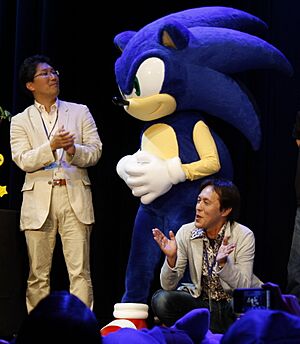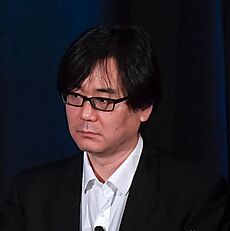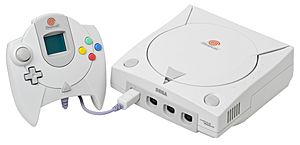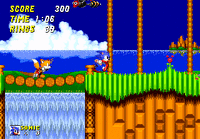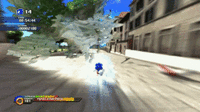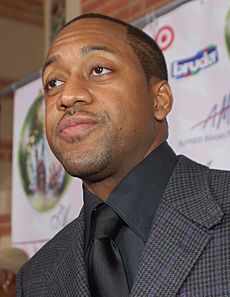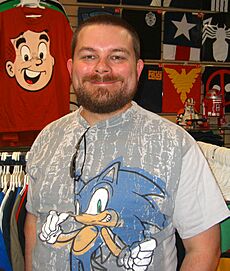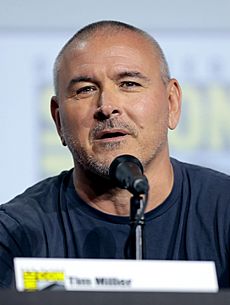Sonic the Hedgehog facts for kids
Quick facts for kids Sonic the Hedgehog |
|
|---|---|
 |
|
| Creator |
|
| Original work | Sonic the Hedgehog (1991) |
| Owner | Sega |
| Print publications | |
| Books | Printed media list |
| Comics | Comic book list |
| Films and television | |
| Films | Films list |
| Television series | Television series list |
| Games | |
| Video games | List of games |
| Miscellaneous | |
| Toys | Lego Sonic the Hedgehog |
Sonic the Hedgehog is a super-fast video game series and media franchise. It was created by Japanese developers Yuji Naka, Naoto Ohshima, and Hirokazu Yasuhara for Sega. The series stars Sonic, a blue hedgehog who can run at amazing speeds. He constantly battles the clever but mad scientist Doctor Eggman and his robot army.
Most main Sonic the Hedgehog games are platformers, made by Sonic Team. Other games, from different studios, include spin-offs like racing, fighting, party, and sports games. The Sonic world also includes comic books, animated shows, movies, and lots of merchandise.
The very first Sonic game came out in 1991 for the Sega Genesis. Its creators wanted Sega to have a cool mascot to compete with Nintendo's Mario. The game was a huge hit! It helped Sega become a top video game company in the early 1990s. Sega Technical Institute made the next three main Sonic games. They also made the spin-off Sonic Spinball (1993). Many Sonic games were also made for Sega's 8-bit consoles, like the Master System and Game Gear.
After a quiet period during the Saturn console era, the first big 3D Sonic game, Sonic Adventure, launched in 1998 for the Dreamcast. In 2001, Sega stopped making consoles and started making games for other companies. The Sonic series continued on Nintendo, Xbox, and PlayStation systems. Takashi Iizuka has been the main producer for the series since 2010.
Sonic games often feature a special health system using rings. They also have famous levels like Green Hill Zone and super-fast gameplay. Sonic usually tries to stop Eggman's plans to take over the world. Players guide Sonic through levels with springs, slopes, and vertical loops. Later games added many new characters. Some, like Miles "Tails" Prower, Knuckles the Echidna, and Shadow the Hedgehog, even got their own spin-off games. The franchise has also had crossovers with other series. These include games like Mario & Sonic, Sega All-Stars, and Super Smash Bros.. Beyond games, Sonic has comic books, animated shows, live-action movies, and toys, including Lego sets.
Sonic the Hedgehog is Sega's most important franchise. It is one of the best-selling video game franchises ever. It is also one of the highest-earning media franchises. By 2024, game sales and free-to-play mobile game downloads reached over 1.77 billion. The early Genesis Sonic games are seen as important parts of the culture of the 1990s. They are often listed among the greatest games of all time. While some later games, like the 2006 game, received lower reviews, Sonic is still very important in video games. It is often mentioned in popular culture. The franchise is also known for its dedicated fans. These fans create their own unofficial content, like fan art and fan games.
Contents
The History of Sonic
How Sonic Began: 1990–1991
In 1990, Sega wanted to be a leader in the video game world. They had their 16-bit console, the Sega Genesis. But Nintendo was very popular, and the Genesis was not selling as well. Sega of America's CEO, Michael Katz, tried to compete with marketing campaigns. But Nintendo still dominated. Tom Kalinske, who used to work at Mattel, then took over as CEO.
Sega's president, Hayao Nakayama, knew Sega needed a main character and game series. This character would compete with Nintendo's Mario franchise. Nintendo had just released Super Mario Bros. 3, which was a huge seller. Nakayama wanted a star character in a game that showed off the Genesis's power. Sega held a contest to find this new game, focusing on what American players would like. Artist Naoto Ohshima and programmer Yuji Naka were among those working on ideas.
The idea for Sonic the Hedgehog (1991) came from a special test by Naka. He made a program that let a character move smoothly on curves. Naka's first idea was a platform game where a fast character rolled in a ball through a long tube. Sega liked this idea. Designer Hirokazu Yasuhara then joined Naka and Ohshima.

After Yasuhara joined, the team focused on the main character. Sega hoped this character would become their mascot. They first thought of a rabbit that could grab things with its ears. But this was too hard for the game system. They then tried animals that could roll into a ball. Finally, they chose Sonic, a blue hedgehog designed by Ohshima. Sonic's color matched Sega's blue logo. His red and white shoes were inspired by a famous album cover. His personality was based on a "can-do" attitude. The bad guy, Doctor Eggman, was another character Ohshima had designed. The team loved this design and made him the villain. The team called themselves Sonic Team when the game came out.
Sonic first appeared as a small ornament in the racing game Rad Mobile (1991). This was five months before his own game. The Sonic creators wanted to show him to the public. Some American staff at Sega thought Sonic would not be popular. But Tom Kalinske decided to include Sonic the Hedgehog with every Genesis console. The game, with its super-fast action, was a big hit with critics. It made the Sega Genesis much more popular in North America. This helped Sega gain a large share of the market against Nintendo.
Genesis Success: 1991–1995
Yuji Naka was not happy with how he was treated at Sega. He felt he did not get enough credit for the game's success. He left but was soon hired by Sega Technical Institute (STI) in the US. He got a better salary and more creative freedom. Yasuhara also moved to STI. STI started making Sonic the Hedgehog 2 (1992) in November 1991. Level artist Yasushi Yamaguchi created Sonic's new friend, Tails. Tails is a flying fox with two tails, inspired by a Japanese myth. Sonic the Hedgehog 2 was also a huge success. However, making the game was sometimes hard due to language and cultural differences.
After Sonic 2 was finished, STI split into two teams. The Japanese team, led by Naka, started Sonic the Hedgehog 3. This game introduced Sonic's rival, Knuckles. Knuckles was created by artist Takashi Thomas Yuda. Because of a promotion with McDonald's and game size limits, the project was split. The first part, Sonic 3, came out in February 1994. The second part, Sonic & Knuckles, followed a few months later. The Sonic & Knuckles cartridge had a special adapter. Players could connect it to Sonic 3 to create a bigger game called Sonic 3 & Knuckles. Both Sonic 3 and Sonic & Knuckles were highly praised.
To have a Sonic game ready for the 1993 holiday season, Sega asked the American team to make a new game. This was the spin-off Sonic Spinball. While Spinball got mixed reviews, it sold well.
Many Sonic games were also made for Sega's 8-bit consoles. These included the Master System and the Game Gear. The first was an 8-bit version of the original Sonic. It was made by Ancient and released in December 1991. Other Sonic games from this time included Dr. Robotnik's Mean Bean Machine (1993). This was a Western version of the Japanese puzzle game Puyo Puyo. There was also SegaSonic the Hedgehog (1993), an arcade game. And Knuckles' Chaotix (1995), a spin-off for the Genesis's 32X add-on, starring Knuckles.
The Saturn Years: 1995–1998
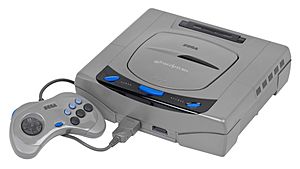
After Sonic & Knuckles, Naka went back to Japan to become a producer. He reunited with Ohshima and brought Takashi Iizuka with him. Sonic Team was officially formed. They started working on a new game, Nights into Dreams (1996), for Sega's Saturn console. In 1996, Sega released Sonic 3D Blast, an isometric game. It was based on an early idea for Sonic 3. Since Sonic Team was busy with Nights, 3D Blast was made by the British studio Traveller's Tales. While it sold well, some criticized its gameplay.
Meanwhile, in America, STI worked on Sonic X-treme. This was a 3D Sonic game for the Saturn. But its development had many problems. These included disagreements between Sega's American and Japanese teams. The game was eventually canceled. Many believe this cancellation was a big reason why the Saturn console did not sell well.
In 1997, Sega launched "Project Sonic" to make the Sonic brand popular again. The first release was Sonic Jam, a collection of the main Genesis Sonic games. It included a 3D area where Sonic Team tested 3D Sonic gameplay. Sonic Team and Traveller's Tales also made Sonic R, a 3D racing game. This was the only original Sonic game for the Saturn.
Moving to 3D: 1998–2005
Using their Sonic Jam experiments, Sonic Team started making a 3D Sonic platformer. This project moved to Sega's new console, the Dreamcast. Naka believed the Dreamcast would allow for the best Sonic game ever. Sonic Adventure, directed by Iizuka, came out in 1998. It was one of the first games for the sixth generation of consoles. It brought in new features that became common in the series. These included artist Yuji Uekawa's new character designs. In 1999, Iizuka and other Sonic Team members moved to San Francisco. They formed Sonic Team USA to make Sonic Adventure 2 (2001). Both Adventure games were well-liked.
In January 2001, Sega announced it would stop making the Dreamcast. They would become a third-party developer, making games for other companies. After this, Yasuhara left Sega. The next December, Sega released an improved version of Sonic Adventure 2 for Nintendo's GameCube. Then, Sonic Team USA made the first multi-platform Sonic game, Sonic Heroes (2003). It was for the GameCube, Microsoft's Xbox, and Sony's PlayStation 2. Reviews for Sonic Heroes were mixed.
Sega also kept making 2D Sonic games. In 1999, they worked with SNK to make Sonic the Hedgehog Pocket Adventure for the Neo Geo Pocket Color. Some SNK staff then formed Dimps. Dimps made original 2D Sonic games for Nintendo's Game Boy Advance (GBA). These included Sonic Advance (2001), Sonic Advance 2 (2002), and Sonic Advance 3 (2004). Sonic Advance was the first original Sonic game for a Nintendo console. Dimps also made Sonic Rush (2005) for the Nintendo DS. These games were generally well-received. To help new fans discover older games, Sonic Team made two collections: Sonic Mega Collection (2002) and Sonic Gems Collection (2005).
Challenges and Changes: 2005–2010
Sonic Team USA changed its name to Sega Studios USA. Sega and Sonic Team tried new ideas for the Sonic series. Their first project after Sonic Heroes was Shadow the Hedgehog (2005). This spin-off starred the popular character Shadow. It was aimed at an older audience and added shooting gameplay. Shadow the Hedgehog received criticism but sold well.
In 2006, for the franchise's 15th anniversary, Sonic Team released Sonic Riders and a new game called Sonic the Hedgehog (often called Sonic '06). Sonic '06 had a darker, more realistic setting. It was meant to restart the series for new consoles like the Xbox 360 and PlayStation 3. But the game faced many problems during development. Naka, the last of the original Sonic creators, left Sonic Team. The team also split to work on a Wii Sonic game. These issues, along with tight deadlines, meant the game was rushed. None of the 15th-anniversary Sonic games were critically successful. Sonic '06 became known as one of the worst games in the series.
Backbone Entertainment made two Sonic games for the PlayStation Portable: Sonic Rivals (2006) and Sonic Rivals 2 (2007). The first Sonic game for the Wii, Sonic and the Secret Rings (2007), was set in the world of Arabian Nights. Sega released a sequel, Sonic and the Black Knight, set in the world of King Arthur, in 2009. These two games are known as the Sonic Storybook series. Dimps also returned with Sonic Rush Adventure (2007). BioWare developed the first Sonic RPG, Sonic Chronicles: The Dark Brotherhood (2008), for the DS.
After Naka left, Akinori Nishiyama became Sonic Team's general manager. Sonic Team started working on Sonic Unleashed (2008) in 2005. It aimed to combine the best parts of 2D and 3D Sonic games. However, reviews were mixed because of a new beat 'em up mode where Sonic turned into a werewolf-like beast. In 2010, Iizuka became the head of Sonic Team and the Sonic producer.
New Focus: 2010–2015

Iizuka felt Sonic needed a clearer direction. So, Sonic Team focused on more traditional side-scrolling and fast gameplay. Sonic the Hedgehog 4, a side-scrolling sequel, started with Episode I in 2010. Episode II followed in 2012. In 2010, Sega released Sonic Colors for the Wii and DS. This game added new Wisp power-ups. For the series' 20th anniversary in 2011, Sega released Sonic Generations. This game featured classic and modern Sonic designs and reimagined old levels. These games were better received than earlier ones.
In May 2013, Nintendo and Sega announced they would work together. They would make Sonic games for Nintendo's Wii U and 3DS. The first game from this partnership was Sonic Lost World (2013). It was designed to be smooth and fluid, taking ideas from Nintendo's Super Mario Galaxy games. The second was Mario & Sonic at the Sochi 2014 Olympic Winter Games (2013) for the Wii U. The deal finished in 2014 with Sonic Boom: Rise of Lyric for the Wii U and Sonic Boom: Shattered Crystal for the 3DS. These games were part of a spin-off series that also included a TV show.
Sega also started releasing more Sonic games for mobile phones. These included iOS and Android devices. In 2013, remakes of the original Sonic the Hedgehog and Sonic the Hedgehog 2 were released for mobile. Sonic Dash (2013), an endless runner game, was downloaded over 350 million times by 2020.
New Directions: 2015–Present
In 2015, Iizuka said that recent Sonic games had been disappointing. He wanted the Sonic Team logo to mean "quality" from then on. He planned to release great games and grow the Sonic brand. At San Diego Comic-Con in July 2016, Sega announced two new Sonic games for the series' 25th anniversary: Sonic Mania and Sonic Forces. Both were released in 2017 for PlayStation 4, Xbox One, Nintendo Switch, and Windows. Sonic Mania was made by independent developers and looked and played like the classic Genesis games. It received the best reviews for a Sonic game in 15 years. Sonic Forces brought back the dual gameplay of Sonic Generations and added custom characters.
In 2019, Sega released a kart racing game, Team Sonic Racing. In May 2021, Sega announced several Sonic projects for the series' 30th anniversary. These included a remaster of Sonic Colors, the collection Sonic Origins, and the 2022 game Sonic Frontiers. Frontiers was the first Sonic game with an open-world design. Iizuka hoped it would influence future games like Sonic Adventure did. Frontiers received good reviews and sold well.
In 2023, Sonic releases included The Murder of Sonic the Hedgehog, a free visual novel. There was also Sonic Dream Team, an Apple Arcade 3D platformer. And Sonic Superstars, a 2.5D side-scrolling game with the classic Sonic design. Ohshima's studio, Arzest, co-developed Superstars. He designed a new character for it, his first contribution since Sonic Adventure. Iizuka stated that 2D and 3D Sonic games would continue separately.
In 2024, Sonic media focused on Shadow the Hedgehog. This was part of Sega's "Fearless: Year of Shadow" campaign. It included the release of Shadow Generations, a short Shadow game bundled with a rerelease of Sonic Generations. Shadow-themed events happened in the mobile games Sonic Dash and Sonic Forces: Speed Battle. Music from Shadow the Hedgehog was featured in the Sonic Symphony World Tour. Shadow also played a big role in the film Sonic the Hedgehog 3.
Characters and Story
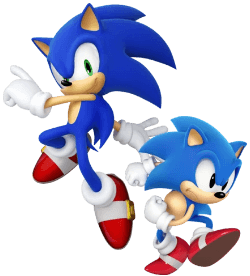
The Sonic series is famous for its many characters. The first game introduced Sonic, a blue hedgehog who runs super fast. It also introduced Doctor Eggman, a round, crazy scientist. In Western countries, Eggman was first called Doctor Ivo Robotnik. Since Sonic Adventure, he has been called Eggman everywhere, but the Robotnik name is still known.
Sonic games usually follow Sonic's quest to stop Eggman. Eggman always tries to get the Chaos Emeralds. These are seven powerful gems from outer space. They can turn thoughts into power, change time and space, and give energy. Eggman wants the Emeralds to take over the world. He traps animals in his robots and cages. The Sonic games also have themes about nature. Sonic represents "nature," while Eggman represents "machines" and "development." This reflects a real-world discussion about nature and progress.
Many other characters joined the cast in later games. Sonic 2 introduced Sonic's best friend, Miles "Tails" Prower. Tails is a fox who can fly using his two tails. Sonic CD brought in Amy Rose, a pink hedgehog who says she is Sonic's girlfriend. It also introduced Metal Sonic, a robot copy of Sonic made by Eggman. Sonic 3 introduced Sonic's rival, Knuckles. Knuckles is a red echidna who guards the Master Emerald. The Master Emerald, from Sonic & Knuckles, controls the power of the Chaos Emeralds.
During Sonic Adventure's development, the simple character designs needed updating for 3D. The art style was changed to make characters look more modern and appealing. Since Sonic Adventure, the series has added many more characters. These include Big, a large cat who fishes for his pet frog. There's also Shadow, a serious black hedgehog. Rouge is a bat who hunts for treasure. Cream is a polite young rabbit. Blaze is a cat from another dimension. And Silver is a telekinetic hedgehog from the future. The Chao are cute creatures that act like digital pets. Wisp creatures give special power-ups.
Some Sonic characters have starred in their own spin-off games. Eggman is the main character in Dr. Robotnik's Mean Bean Machine. This game replaced the original Japanese characters with Sonic characters. In 1995, Knuckles got his spin-off, Knuckles' Chaotix. Tails also got two spin-offs for Game Gear: Tails' Skypatrol and Tails Adventure. Shadow the Hedgehog (2005) was made because Shadow was so popular. It added "gun action" gameplay to the series.
How to Play Sonic Games
The Sonic series is known for its fast-paced platforming. Players control a player character like Sonic. They race through levels at high speeds. Players jump between platforms, fight enemies, and avoid dangers. The series has both 2D and 3D games.
2D games are usually simple and fast, like a pinball machine. You jump and attack with one button. Levels often have different paths, and you need to remember them to keep your speed. 3D games are often more straightforward. They have different goals, more moves, and you can upgrade your character. Games since Sonic Unleashed mix 2D and 3D gameplay. The camera switches between side-scrolling and third-person views.
A special part of Sonic games are the golden rings you collect. These rings act like your health. If you have rings and get hit, you lose them all, but you don't lose a life. You have a short time to grab some rings back before they disappear. Collecting 100 rings usually gives you an extra life. Rings can also be used for other things, like money in Sonic '06 or to fill a boost gauge.
Sonic levels have things like slopes, bottomless pits, and vertical loops. Springs and dash panels launch you forward at high speeds. Checkpoints save your progress in levels. Some famous places, like Green Hill Zone, appear in many games.
There are many power-ups in Sonic games. They are found in boxes throughout the levels. An icon on the box shows what's inside. You break the box to get the item. Common items include rings, shields, invincibility, super speed, and extra lives. Sonic Colors introduced the Wisps, alien creatures that give special powers. Each Wisp has a unique ability. For example, yellow Wisps let you drill underground. Since Sonic Rush, most Sonic games have a "boosting" mechanic. This lets Sonic instantly speed up to top speed. Boosting lets you smash through objects and enemies. But you need to react quickly to obstacles. Boosting is limited by a gauge that you fill with rings or Wisps.
In most Sonic games, your main goal is to collect the Chaos Emeralds. You need to collect all seven to defeat Eggman and get the best ending. Some games, like Sonic CD, have different collectibles that work similarly. You find Emeralds by entering special portals or by finding them in levels. Collecting the Emeralds lets your character transform into a "Super" form. This form gives you more speed, a higher jump, and invincibility. But your rings drain quickly, and the transformation ends when you run out.
Many Sonic games have multiplayer and cooperative gameplay. This started with Sonic the Hedgehog 2. In some games, a second player can join and control Tails. Sonic games also have a split-screen mode where two players race against each other.
Music in Sonic Games
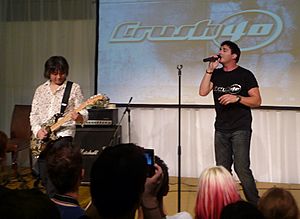
For the first Sonic the Hedgehog game, Sega asked Masato Nakamura to create the music. Nakamura was the bassist for the band Dreams Come True. He also composed the music for Sonic 2.
Many composers worked on the Sonic the Hedgehog 3 music. There have been discussions about whether pop musician Michael Jackson was involved in composing some of the music for Sonic 3. His contributions were either changed or removed due to unforeseen circumstances during development.
Sonic 3 was the first Sonic game for composer Jun Senoue. Senoue has composed music for many Sonic games since Sonic 3D Blast. He often works with his band Crush 40. Early Sonic soundtracks had an electropop style. Senoue's music often features funk and rock music. Tomoya Ohtani has been the series' sound director since Sonic the Hedgehog in 2006. He was the lead composer for many games, including Sonic Unleashed and Sonic Colors. Ohtani tries to make music that fits each game's unique features.
Other composers have also worked on Sonic games. These include Richard Jacques and Hideki Naganuma. Tee Lopes, known for his Sonic music remixes online, was the lead composer for Sonic Mania.
Other Sonic Adventures
Crossovers with Other Games
Sonic has appeared in other games outside his own series. He was a playable character in Christmas Nights (1996). He was also a power-up in Billy Hatcher and the Giant Egg (2003). Sonic characters also appear in the Sega All-Stars series. These include racing games like Sonic & Sega All-Stars Racing (2010).
From 2007 to 2020, Sega and Nintendo teamed up for Mario & Sonic games. These games were based on the Olympic Games and featured characters from both Mario and Sonic. The first Mario & Sonic game came out in 2007. The series ended in 2020 when the International Olympic Committee did not renew its licensing deal.
Sonic is also a playable character in Nintendo's Super Smash Bros. fighting games. He first appeared in Super Smash Bros. Brawl in 2008. Sonic was one of the first characters from outside Nintendo to join Smash. He returned in later games like Super Smash Bros. for Nintendo 3DS and Wii U (2014) and Super Smash Bros. Ultimate (2018).
In June 2015, characters from Angry Birds Epic appeared in Sonic Dash. Sonic also appeared in Angry Birds Epic. Similar crossovers happened with Hello Kitty and Pac-Man. In November 2016, a Sonic expansion pack was released for the game Lego Dimensions. This pack included Sonic as a playable character.
Animated Shows
In 1992, Sega worked with American Broadcasting Company (ABC) to make two Sonic TV shows. These were Adventures of Sonic the Hedgehog (1993) and Sonic the Hedgehog (1993–1994). Both were made by DIC Entertainment. DIC also made a Sonic Christmas special in 1996 and Sonic Underground in 1999. In all three DIC series, Sonic was voiced by actor Jaleel White.
Adventures of Sonic the Hedgehog had 65 episodes and was full of slapstick humor. The 26-episode Sonic the Hedgehog (also called Sonic SatAM) had a more serious story. In it, Eggman had taken over the world, and Sonic was part of a resistance group. Sonic Underground followed Sonic and his siblings as they used music to fight Eggman.
In Japan, Sega and Sonic Team made a two-part animated video, Sonic the Hedgehog, released in 1996. This video was later released in North America as Sonic the Hedgehog: The Movie. It was loosely based on Sonic CD and other games.
Sonic X, an anime series, ran for three seasons from 2003 to 2006. It told one long story. The Sonic characters were transported to Earth and met a human boy, Chris Thorndyke. They tried to return home while fighting Eggman. Sonic X was very popular in the US and France.
Sonic Boom, an animated TV series, started in November 2014. It had a funny, satirical take on the Sonic world. The characters were redesigned for it. Sonic Boom lasted for two seasons, with the last episode airing in 2017.
To promote Sonic Mania Plus (2018), a five-part series of animated shorts, Sonic Mania Adventures, was released online in 2018. These shorts showed Sonic returning to his world after Sonic Forces.
Sonic Prime, an animated Sonic series, started on Netflix in December 2022. It was co-produced by Netflix Animation and Sega. This series is part of the official Sonic game story. It follows Sonic into a multiverse after he breaks an artifact. He meets different versions of his friends and enemies.
Comic Books
Shogakukan published a Sonic the Hedgehog manga series in Japan starting in 1992. It followed a shy hedgehog named Nicky who had a brave alter ego, Sonic. This manga helped promote Sonic to younger kids. Characters like Amy Rose and Charmy Bee first appeared in this manga before the games.
The longest-running Sonic comic was Sonic the Hedgehog by Archie Comics. It ran for 290 issues from 1993 to 2017. Archie also made spin-offs like Knuckles the Echidna. The Archie comic was based on the Sonic the Hedgehog TV series. It showed Sonic and his friends fighting the evil Eggman. Ian Flynn became the main writer in 2006. After a legal issue, the series was restarted in 2013. Only characters from the games or those created before the legal issue remained.
In 2008, Guinness World Records recognized Archie's Sonic the Hedgehog as the longest-running comic based on a video game. In July 2017, Sega ended its partnership with Archie. They started a new one with IDW Publishing. IDW's Sonic comic began in April 2018. Many of the same writers from Archie, like Flynn, returned. The IDW series tells new stories based on the games.
Sonic the Comic, a British comic by Fleetway Publications, ran from 1993 to 2002. It featured stories, news, and reviews for children. It adapted game stories but also created its own world.
Sega and DC Comics announced a Sonic partnership in 2024. This began with DC x Sonic the Hedgehog, a five-issue series in March 2025. In it, Sonic characters take on roles like Batman and the Flash.
Live-Action Movies
Since 2020, Paramount Pictures has released a series of live-action animated Sonic movies. These films are directed by Jeff Fowler and produced by Neal H. Moritz. Development started in 2013 with Sony Pictures Entertainment. Paramount later acquired the rights in 2017.
The first movie, Sonic the Hedgehog, was released in February 2020. It follows Sonic (voiced by Ben Schwartz) as he travels to San Francisco with a small-town cop (James Marsden). They try to escape Eggman (Jim Carrey) and find Sonic's missing rings. Sonic's initial design for the movie was changed after fans reacted negatively. The film was delayed so Sonic could look more like his game design. The movie received positive reviews. It became the highest-grossing film based on a video game in US box office history at the time.
Sonic the Hedgehog 2 was released in April 2022. In this film, Sonic and Tails try to stop Eggman. Eggman works with Knuckles to find the Master Emerald. The movie included more elements from the Sonic games. It also introduced Shadow in a special scene. Sonic 2 received positive reviews and earned even more than the first film.
Knuckles, a spin-off streaming television series for Paramount+, premiered in April 2024. The story takes place after Sonic 2. It follows Knuckles as he trains a new student.
Sonic the Hedgehog 3 was released in December 2024. It adapted the story of Sonic Adventure 2. Schwartz, Colleen O'Shaughnessey (as Tails), Idris Elba (as Knuckles), Carrey, Marsden, and Tika Sumpter all returned. Keanu Reeves voiced Shadow. Sonic 3 was highly rated. A fourth film, Sonic the Hedgehog 4, is planned for release in early 2027.
As of January 2025, the Sonic film series has earned over US$1 billion worldwide. Some elements from the movies have even been added to the Sonic games.
Cool Merchandise

There's lots of official Sonic merchandise! This includes books, clothes, music, board games, and toys like figures and plushies. By 2004, the Sonic the Hedgehog franchise had made over $1 billion from licensed merchandise sales. Sega and McDonald's worked together for Sonic-themed Happy Meal promotions in 1994 and 2004. Sonic was the first video game franchise to be promoted in McDonald's. Over 50 million Sonic Happy Meal toys were sold worldwide.
First4Figures has made many Sonic figures since 2008. In 2021, Sega and The Lego Group created a Green Hill Zone Lego set. This was followed by a full Lego Sonic the Hedgehog theme in 2023. In 2025, Magic: The Gathering cards with Sonic themes were released.
Special Events
On June 23, 2021, Sega celebrated Sonic the Hedgehog's 30th anniversary. They presented the Sonic the Hedgehog 30th Anniversary Symphony concert. It was a free live stream online. It featured orchestral music by the Prague Philharmonic Orchestra and rock music by the Tomoya Ohtani Band and Crush 40. This concert started the Sonic Symphony World Tour. Live concerts took place in late 2023 and 2024.
See also
 In Spanish: Sonic the Hedgehog (serie) para niños
In Spanish: Sonic the Hedgehog (serie) para niños


